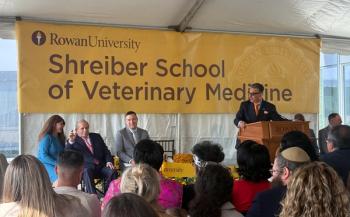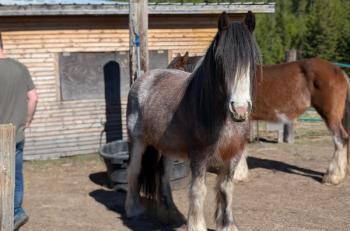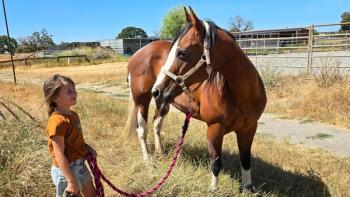
Non-exertional myopathies (Proceedings)
Characterized by clinical and laboratory findings of muscle damage not associated with exercise. Includes inflammatory, nutritional, toxic, traumatic, metabolic, congenital, immune mediated and idiopathic causes of muscle disease.
Characterized by clinical and laboratory findings of muscle damage not associated with exercise. Includes inflammatory, nutritional, toxic, traumatic, metabolic, congenital, immune mediated and idiopathic causes of muscle disease.
Inflammatory myopathies: Myopathy related to infectious agents or immune mediated damage.
Clostridial myositis:
• Rapid, progressive muscle necrosis associated with multiplication of Clostridium within muscle and a systemic inflammatory response. Also called blackleg, gas gangrene and malignant edema.
• Affects horses, humans, ruminants and other species.
Infection may occur via direct inoculation (injection site or a wound) or from spores present in the muscle tissue and proliferate in response to triggering factors such as trauma.
• Clinical signs: In horses: usually arises at IM injection sites (80% of cases), but can develop in regions of muscle trauma and in open wounds. Clinical signs arise within 48 hours. Firm, hot, swollen and painful area often with crepitance. Tachycardia, tachypnea, fever and lameness are common. Complications include IMHA, coagulopathies and laminitis. Clostridium septicum and Clostridium perfringens are the most frequently isolated organisms in horses.
• Lab findings: elevated CK and AST (usually mild), CBC consistent with toxemia and inflammation.
• Diagnosis is based on clinical signs, ultrasonography (fluid pockets, gas production, edema), cytology of aspirated fluid (large gram positive rods) and the growth of Clostridia on anaerobic culture.
• Treatment: Penicillin and/or metronidazole. Surgical debridement and wound flushing. Initial antibiotic treatment is aggressive (penicillin 44 000 IU/kg every 2 to 4 hours until the animal is stable)
• Adjunct therapy: anti- inflammatory drugs, IV fluids, analgesia, hydrotherapy, topical wound therapy, fly control.
• High mortality rate (~ 68%), so early and aggressive therapy is critical. Infections with Cl. septicum are associated higher mortality rate than Cl.perfringens (85% vs. 25%). Cl. sordelli invariably fatal.
• Prevention: no licensed equine vaccine.
Viral myositis:
• Herd outbreaks of equine influenza A2 have been associated with a small % of horses developing severe myositis. Affected horses presented with fever, depression, dehydration and stiffness which progressed to renal failure and death. Virus was isolated from the lungs but not muscle tissue.
• EHV 1 has also been associated with signs of muscle stiffness in some herd outbreaks.
Sarcocystis myositis:
• Cysts of the parasite Sarcocystis are commonly found on microsopic examination of cardiac, esophageal and skeletal muscle of horses.
• Carnivores are definitive hosts, herbivores are intermediate hosts and usually exposed through contamination of feed sources with fecal material from definitive hosts.
• Infection is usually asymptomatic.
• Heavily infected horses may display low grade fever, malaise, stiffness, muscle atrophy and mild elevations in CK with a large number of sporocysts on muscle biopsy with associated neutrophilic or eosinophilic inflammation. Firm lumps may be palpable within the muscle. Affected horses can be treated with anti-inflammatory drugs, anti-protozoal drugs (TMS + pyramethamine, or ponazuril) and potentially corticosteroids if problems persist over time.
Immune mediated and infarctive myopathies:
In the past decade several forms of immune mediated muscle disease have been identified in horses: Immune mediated polymyositis; acute rhabdomyolysis associated with Streptococcus equi infection; and infarctive hemorrhagic purpura. All are associated with elevations of serum CK, but atrophy is a significant clinical feature of immune mediated polymyositis. Horses with PSSM may also develop clinical signs of rhabdomyolysis not related to exertion when they encounter respiratory infections.
Immune-mediated polymyositis:
• Documented mainly in young Quarter horses.
• In ~ ⅓ of affected horses, there is a history of exposure to S. equi or other respiratory disease, or signs of an upper respiratory tract infection prior to the onset of muscle inflammation.
• Clinical signs include depression, stiffness and most prominently, severe progressive muscle atrophy with a distinct predisposition for the epaxial and gluteal muscles. Horses may lose 50% of muscle mass in one week.
• Serum CK activity is usually moderately elevated (mean ~ 20,000 U/L), as is serum AST but can be normal and serum chemistry and CBC analyses are usually otherwise normal.
Samples of muscle tissue from the epaxial and gluteal muscles show immune mediated inflammation - lymphocytic vasculitis, anguloid atrophy, lymphocytic myofiber infiltration, and fiber necrosis with macrophage infiltration and regeneration.
• Untreated cases may develop significant fibrosis (which can be seen on biopsies). Samples of the epaxial and gluteal muscle tend to provide more consistent abnormalities than samples from the semimembranosus muscles
• Treatment: dexamethasone (0.05 mg/kg) for three days, followed by prednisolone (1 mg/kg for 7 to 10 days) tapered by 100 mg/week over one month. Serum Ck normalizes in 7-10 days, muscle mass should gradually recover over two-to-three months.
Atrophy can recur in some horses re-exposed to respiratory infections
Acute rhabdomyolysis associated with Streptococcus equi infection:
• Signs of stiffness and muscle pain arising in young Quarter horses (< 7 years of age) with lymphadenopathy and/or guttural pouch empyema attributable to infection with S. equi.
• Affected horses display a stiff gait and often proceed to recumbency but rarely display the extensive edema associated with classic purpura.
• Laboratory analyses identify mature neutrophilia, hyperfibrinogenemia, marked elevations in CK activity (>115,000 IU/l) and AST, and variable electrolyte derangements.
• Titers to S. equi M protein are low
• Necropsy identifies large areas of necrotic friable muscle tissue predominantly in the gluteal, hamstring and epaxial muscles and histopathology is consistent with profound acute myonecrosis with macrophage infiltration.
• Rhabdomyolysis may result from an inflammatory cascade resembling streptococcal toxic shock or potentially the direct toxic effects of S. equi within muscle tissue.
• The condition is associated with a poor prognosis. Treatment consists of antibiotic therapy, short term high dose steroids, pain relief, deep bedding or slinging, and local treatment of abscesses/empyema.
Infarctive purpura hemorrhagica associated with S. equi infection:
• Presents in adult horses as signs of muscle stiffness and/or colic within three weeks of exposure to or vaccination against S. equi. Classic signs of purpura are present including petechiae, oral ulcers and limb edema, along with focal firm intramuscular swellings. Disease results from formation of immune complexes of streptococcal M protein with serum IgA and IgM
• The disease has also been reported in horses with S. zooepidemicus, C. pseudotuberculosis and Rhodococcus equi infection
Affected horses may display uncontrollable pain and colic signs due to intestinal infarction leading to euthanasia (one horse with muscle swelling and stiffness was successfully treated with penicillin and corticosteroid therapy)
• Affected horses show marked elevations in serum ELISA M protein titer, neutrophilia with a left shift and toxic changes, hypoalbuminemia and marked elevations in CK (> 40,000 u/l) and AST. Peritoneal tap will reflect gastrointestinal infarction if present.
• Ultrasound of affected musculature identifies focal hypoechoic lesions which are consistent with coagulative necrosis on biopsy.
• Necropsy: extensive infarction of skeletal muscles, skin, gastrointestinal tract and lungs and abscessation of a lymph node associated with S equi infection. Histopathologic examination identified leukocytoclastic vasculitis and acute coagulative necrosis resembling infarction.
Traumatic myopathy:
Muscle damage arising from direct impact or compressive/ischemic damage during prolonged recumbency or complicated anesthesia.
Localized post anesthetic myopathy:
• Predisposing factors include inadequate padding, prolonged procedures, inappropriate positioning of the limbs, and poor blood pressure during anesthesia.
• Frequently affected muscles are the dependant triceps and masseter in laterally positioned animals or the gluteal, adductor and longissimus dorsi muscles in dorsally positioned animals.
• Underlying nerves can also be damaged resulting in temporary facial, femoral, peroneal or radial nerve paralysis.
• Clinical signs evident at recovery or within 30-60 minutes - may include facial paralysis, difficulty standing and moving, dropped elbow, crouched hind limb, distress, sweating, and pain, swelling and firmness of the affected muscles. Some horses may be unable to rise.
• Serum CK activity > 2000 U/L and may progressively increase with reperfusion.
• Treatment: Treat aggressively to limit muscle swelling, to control pain and to limit the deleterious effects of myoglobinuria. IV fluids, serial monitoring of myoglobinuria and muscle enzyme activity, anti-inflammatory and analgesic drugs, and potentially dantrolene sodium. Horses should be encouraged to stay standing and may require a sling.
• Recovered animals frequently develop atrophy of the affected area.
• Prevention: adequate padding during procedures, removing halters, limiting duration of anesthesia, adequate limb positioning (elevating the upper limb, pulling the lower limb forward), maintaining a mean arterial pressure above 65 mmHg and possibly pre-medicating with dantrolene (heavy horses) at 6 mg/kg orally or by nasogastric tube to a horse fasted 4 hours or less to enhance absorption.
Nutritional myopathy:
A deficiency of vitamin E and/or selenium has been linked to several diseases in horses, including lower motor neuron disease (ELMN), equine degenerative myelencephalopathy (EDM), masseter myositis and acute skeletal and cardiac muscle necrosis. Deficiency has not been proven to play a significant role in chronic exertional rhabdomyolysis in horses. Deficiency in vitamin E and particularly Se can result in disease in young animals of many species, including horses.
• Laboratory analysis: usually very elevated CK (thousands) and AST, LDH. Electrolyte derangements (hyperkalemia, hyperphosphatemia, hyponatremia/chloremia) and myoglobinuria occur with severe rhabdomyolysis.
• Diagnosis: Low whole blood or liver [selenium], low plasma [vitamin E], low glutathione peroxidase activity, characteristic muscle necrosis on necropsy and/or muscle biopsy.
• Treatment: injectable selenium 2.5 to 3 mg per 45 kg of body weight IM or SQ. Be careful of Se toxicity. Appropriate adjunct therapies (IV fluids, pain relief).
• d-alpha tocopherol, at 2000-10000 IU/day for adult horse
• Pathophysiology:
o Se and vitamin E are important biologic antioxidants. Vitamin E is a free radical scavenger which prevents formation of lipid hydroperoxides. Se dependant glutathione peroxidase destroys hydrogen peroxide and lipoperoxides already formed.
Prevention:
o Forages and grains from the northeast, east, and northwest US are particularly deficient in Se from low soil levels. Soils treated with sulfur fertilizers are also low in Se since sulfur inhibits Se uptake by plants and absorption by animals. Forage Se content is lower during periods of rapid growth in spring or high rainfall. Selenium can be supplemented in the ration at recommended amounts.
o Vitamin E deficiency occurs when animals are fed poor quality hay, straw or root crops. Storage of grain for extended periods or treating with proprionic acid reduces the vitamin E content. Feed good quality green forage.
o Mares in Se deficient areas can be treated with 1mg of oral Se per day. Placental transmission may be limited, so supplementation should be continued during lactation. An injectable supplement for neonates shortly after birth is often used in deficient areas.
Toxic myopathies:
Multiple toxic agents can cause rhabdomyolysis. The more important agents are ionophore growth promotants and tremetone containing plants.
• Horses are very sensitive to ionophores commonly contained in cattle feed. Acute toxicity can present as myoglobinuria and death, but frequently a more chronic syndrome of cardiomyopathy occurs.
• White snakeroot (Eupatorium rugosum) and Rayless golden rod contain tremetone toxins that cause acute skeletal and cardiac necrosis. Tremetone remains toxic in dried form and toxicity requires ingestion of 0.5-2% bodyweight.
• A syndrome of non-exertional rhabdomyolysis referred to as 'pasture myopathy' or 'atypical myopathy' has been recognized in the UK, and cases have also been observed in the US.
o Occurs usually in spring and fall, usually during cold, wet conditions.
o Animals have severe rhabdomyolysis that rapidly leads to recumbency, renal failure and death.
o At necropsy, extensive necrosis of postural and respiratory muscles is noted, and in 50% of cases, also myocardial involvement. n 10 Frozen sections of affected muscles show marked intracellular lipid accumulation in oxidative fibers.
o An ingested or enterically produced toxin that disrupts lipid metabolism is suspected.
Metabolic myopathies:
The major syndromes in this category that are associated with non-exertional rhabdomyolysis include Glycogen Branching Enzyme Deficiency (GBED) and Polysaccharide Storage Myopathy (PSSM). PSSM is a common metabolic muscle disorder that can result in muscle necrosis and elevated muscle enzyme activity not necessarily related to exertion. PSSM will be discussed in lectures on exertional rhabdomyolysis.
Glycogen Branching Enzyme Deficiency:
GBED is a fatal glycogen storage disorder recently identified in Quarter Horse foals. Arises from a deficiency in the glycogen branching enzyme (GBE) responsible for producing a normally configured glycogen molecule in numerous tissues.
• Clinical signs likely arise from a lack of intracellular glucose stores for normal tissue metabolism.
o Foals may be stillborn in the last trimester, weak after birth, or live to up to 18 weeks.
o Sudden death may occur, or animals may be persistently recumbent.
o Flexural deformities of limbs and recurrent hypoglycemia and seizures occur in some foals.
o Leukopenia, intermittent hypoglycemia and increased serum CK, AST, GGT are common.
o Routine necropsy usually finds few abnormalities. Periodic acid Schiff's (PAS) staining of muscle, heart and liver show variable amounts of abnormal PAS positive globular or crystalline intracellular inclusions. GBE activity is minimal in tissues of affected foals and the GBE protein is not detectable by Western blot.
o Autosomal recessive trait. It is estimated that 8 to 9% of Quarter Horses and paint horses carry the mutation. Significant cause of abortion and foal mortality.
o A diagnosis of GBE deficiency should be suspected in foals that present with hypothermia, weakness, contracture of all limbs at birth and have a combination of persistent hypoglycemia, leukopenia, elevated CK (1000-15,000 U/L), AST and GGT. n 10 Genetic testing for GBED is available at the University of California, Davis, Veterinary Genetics Laboratory (
Newsletter
From exam room tips to practice management insights, get trusted veterinary news delivered straight to your inbox—subscribe to dvm360.






